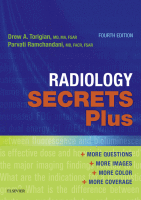Physical Address
304 North Cardinal St.
Dorchester Center, MA 02124

1 What are some common indications for performing magnetic resonance imaging (MRI) of the hand and wrist? MRI of the wrist is routinely used to assess a wide variety of osseous and soft tissues abnormalities, including radiographically occult fractures; tendon,…

1. Name the labeled structures of the elbow shown on magnetic resonance imaging (MRI) in Figures 53-1 and 53-2 . 2. What are the three articulations of the elbow? The radiocapitellar, ulnotrochlear, and proximal radioulnar joints. The three articulations are…

1 Describe the imaging planes used for evaluating the shoulder on a magnetic resonance imaging (MRI) examination. How should the patient be positioned in the scanner? Oblique coronal, oblique sagittal, and axial planes are routinely used ( Figure 52-1 ).…

1 What radiographic features are considered when evaluating a suspected bone tumor? When evaluating a suspected bone tumor, morphologic features, location in a bone (epiphysis, metaphysis, diaphysis), distribution within the skeleton (axial vs. appendicular), presence of tumor matrix, periosteal reaction,…

1 What is the role of imaging in the diagnosis of musculoskeletal infection? Imaging examinations can help to diagnose the presence of and delineate the extent of infection involving the soft tissues or bone. However, radiologists rely on correlative clinical…

1 What kinds of joints exist? Joints can be categorized based upon their structure and function. Fibrous joints such as the skull sutures (synarthrosis) demonstrate minimal to no mobility. Cartilaginous joints such as the intervertebral discs (amphiarthrosis) are slightly more…

1 What is osteoporosis? How does it differ from osteopenia, osteomalacia, and osteosclerosis? Osteoporosis is characterized by diminished bone density with otherwise normal bone architecture. The main radiographic finding is cortical thinning. Loss of bony trabeculae may also be seen.…

1 What are the indications, advantages, and disadvantages of radiography, computed tomography (CT), and magnetic resonance imaging (MRI) in the evaluation of the spine? Radiography of the spine may be obtained to assess for vertebral alignment, fractures including compression deformities,…

1 What are the roles of radiography, computed tomography (CT), and magnetic resonance imaging (MRI) in the evaluation of spinal trauma? When it comes to spinal trauma evaluation, CT has largely replaced radiography given its higher sensitivity for detection of…

1 What is the role of radiography, computed tomography (CT), and magnetic resonance imaging (MRI) in the evaluation of extremity trauma? Radiography remains the mainstay for the assessment of acute skeletal trauma with the exception of cervical spine trauma, which…